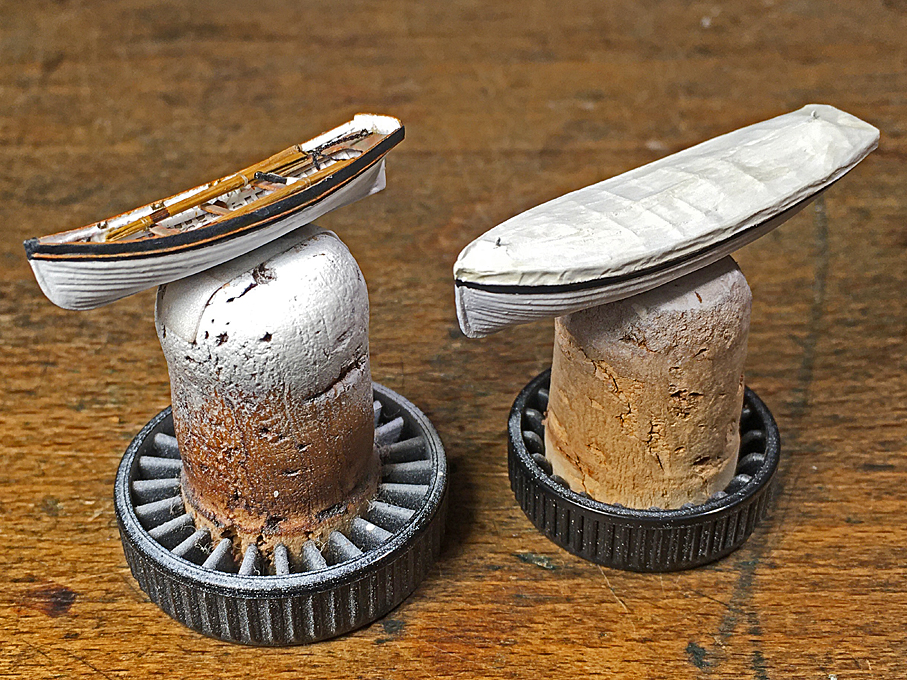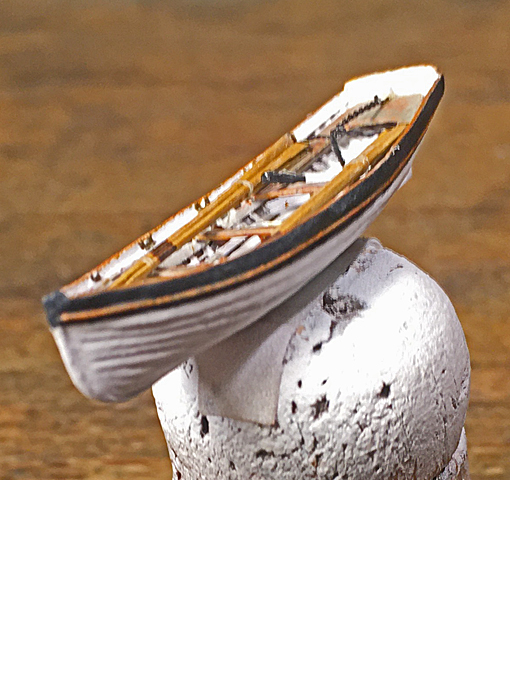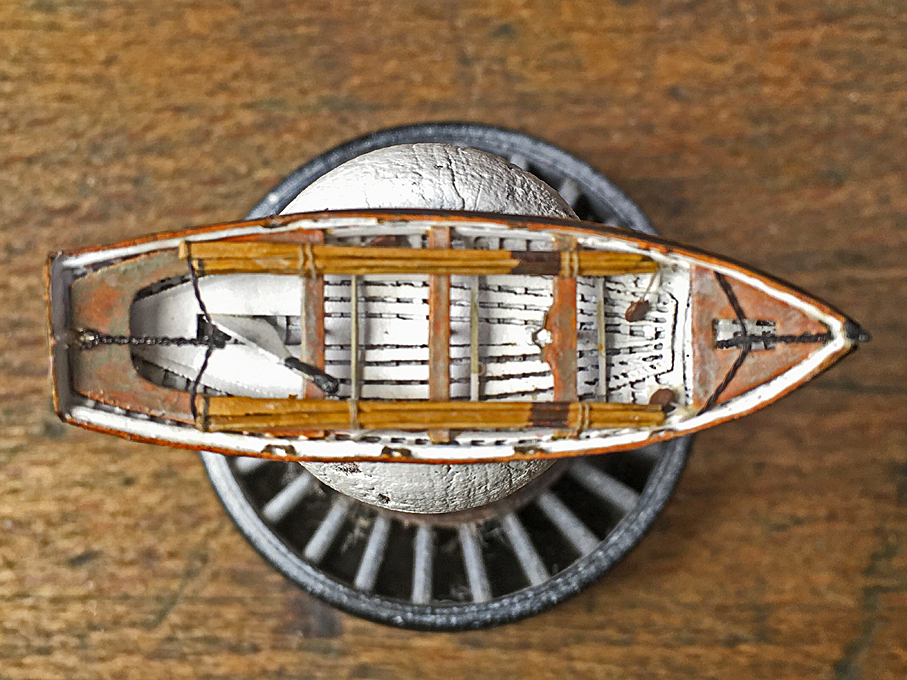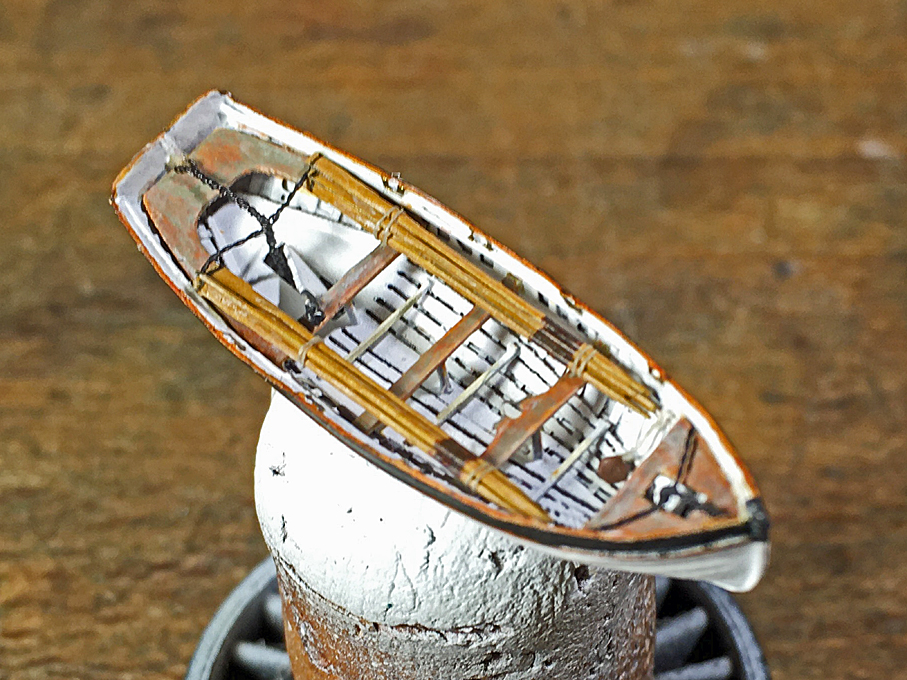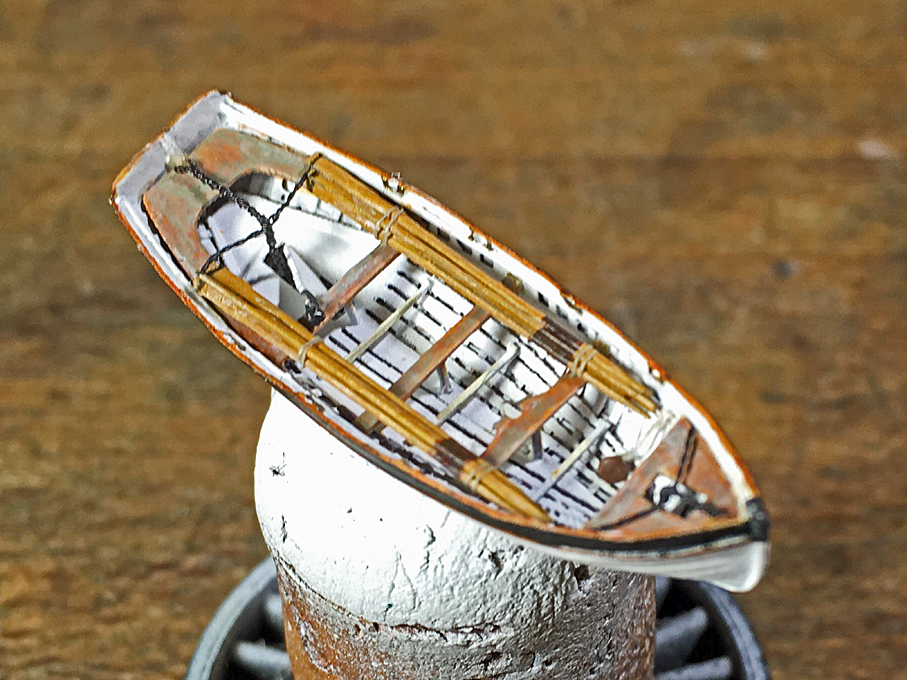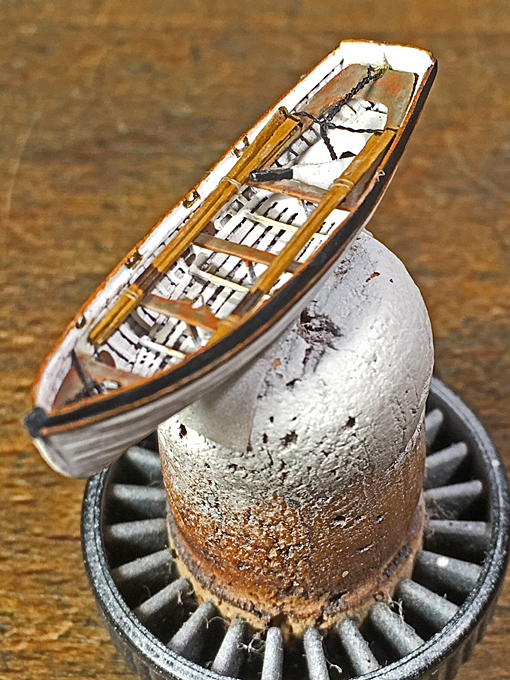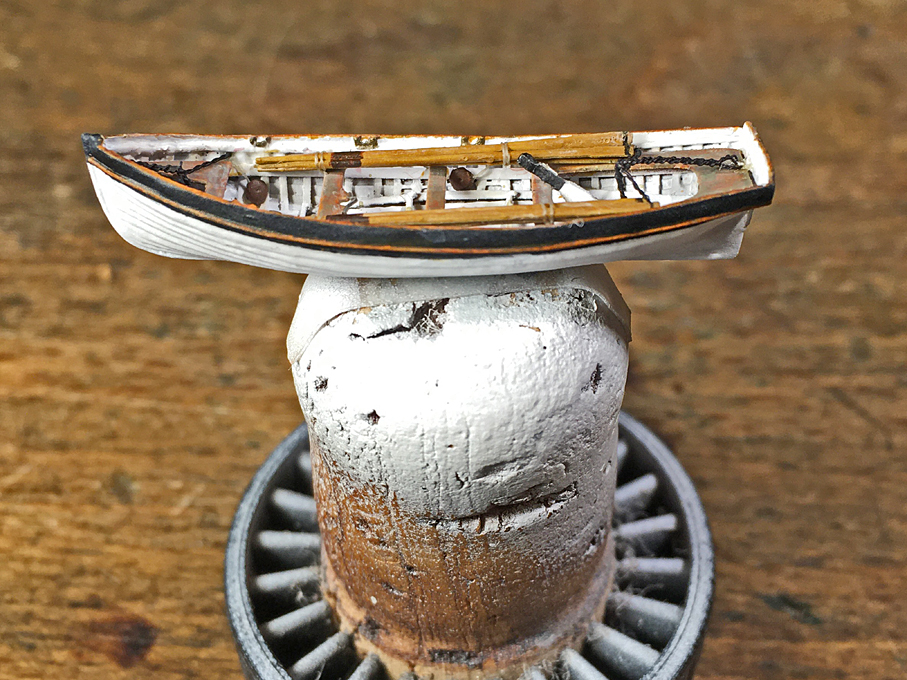-
Posts
6,638 -
Joined
-
Last visited
Content Type
Profiles
Forums
Gallery
Events
Everything posted by wefalck
-
I am not so familiar with 18th century rigging practice, but brails on the mainsail (no. 24 and 25) are definitively needed to reduce sail area quickly. However, you need to decide, whether the vessel would have had a standing or a lowering gaff. If the boat has a lowering gaff, it probably does not make much sense to lead an other running rigging, such as bulins or topgallant braces towards it. I would also doubt that there have been bulins (21/22) or even topgallant braces (10). On British cutters of that period the topgallant braces were led towards the end of the jibboom and belayed at the spill. The topsail- and topgallant yards may not have had braces at all, as the were set flying (at least the topgallant) and would come around together with the main yard. Aren't there any backstays for the topmast? Just having a stay would not be enough to steady it, as the main force is from behind and sideways.
- 71 replies
-
Could you please provide some background information, for instance what model you are talking about? Then people can give some more specific advice. The rigging consists of many different sizes of rope, depending on their function.
-

Harriet McGregor by Boccherini
wefalck replied to Boccherini's topic in - Build logs for subjects built 1851 - 1900
Grant, it wasn't meant to be a 'lesson', just some observations. If sources tell you that the binnacle had (at some stage) Kelvin balls, that's it then. Ships change over time, so it is extremely difficult to represent a particular ship 'correctly'. Your sources from different times may show you certain features, but unless you have corroborating sources, you cannot know whether at another time the same features were present. So you may indadverntely create anachronisms simply because you don't know any better. That's the fate of any modeller. Contextual historical information, say the date of the Kelvin patent, can help you bracketting the time, when certain features could be present on a particular ship. -
Would be interesting to read the technical information sheet for this. From the description I would guess that is is a pure acrylics solution, no pigments and fillers. In this sense it is a primer, rather than a sanding sealer. How does this stuff sand? My experience is that acrylics are too soft to sand well or at least one has to let them cure for weeks.
-

Harriet McGregor by Boccherini
wefalck replied to Boccherini's topic in - Build logs for subjects built 1851 - 1900
Nice work on the binnacle/compass! These 'Kelvin-balls' are there to correct the 'deviation' (horizontal deflection) of a compass caused by iron elements used in the construction or of iron articles in the load. Ther is also a vertical deflection called 'inclination' that is compensated for in later magnetic compasses. On road-steads there was usually an area set aside so that ships could steer a full 360° circle while making compass readings and observations of two given landmarks at the same time. This allowed to plot the 'deviation' of the compass readings from the theoretical readings. This plot was used to adjust the 'balls' in order to minimise the deviation. In the absence of such adjusting features, the 'deviation table' could also be used during a voyage to correct the course. I am not sure though, whether a wooden sailing ship, such as HARRIET McGREGOR would have had at that time this kind of correction features. There were older correction features, but they are not as prominent. -
Shellac is also a traditional cement used by jewellers and watchmakers. The latter use it in molten form to stick (temporarily) metal parts together. Dipped in alcohol, the parts separate. A while ago, I got myself shellac-flakes and dissolved a lot of them just in a few millilitres of alcohol to make a cement with honey-like consistency. It grabs quite well, but it takes quite a while for the alcohol to evaporate. When working with it, the 'open' time is quite infinite, giving you lots of time to adjust parts. As any excess can be wiped off with a brush dipped into alcohol, it makes for a neat cement.
-
It seems that some of the more precious decorations were actually removable at least on some types of ships. They took them off before putting to sea seriously or going into battle. The Musée de la Marine here in Paris has inter alia a collection of decorations from an 18th century chebec that survived, because they were kept in storage in the arsenal of Toulon. Sometimes such carved decorations were also recycled for new ships. From a socio-economic perspective, battle- or storm-damage provided the shipyard and arsenal workers with their daily bread.
- 2,699 replies
-
- heller
- soleil royal
-
(and 9 more)
Tagged with:
-
The point of a wood sealer or sanding sealer is that it should penetrate into the wood. There are two properties that help this process, low viscosity and good wetting behaviour. These are properties that PVA doesn't really have, it has, if undiluted, a high viscosity and being 'polar' (sorry for the chemistry-speak), it is being repelled from more or less resinous wood. Good sanding sealers are based on some kind of organic solvent (which includes alcohol in the case of shellac) and quite thin, so it really soaks into the wood, rather than forming a layer on top. A sealer has to be 'worked' into the wood - in the old days shellac was applied with a 'tampon'. Modern sanding sealers are usually applied with a bristle-brush. So, application by air-brush would be counterproductive.
-

US 6” gun by RGL - FINISHED - Panzer Concepts
wefalck replied to RGL's topic in Non-ship/categorised builds
I am always a bit surprised, how 'spidery' early US American tractors look in comparison to their European cousins. I gather they used more fabricated parts than castings. -
A university friend of mine some 40+ years ago built a side-car for his antique BMW motorcycle from scratch. He got somewhere the original plans and some parts, such as bearings and the wheel, but the rest was built from scratch. Somehow he managed to sell it to the licensing authorities as a restored/recovered original ... I had a lot of trust in his engineering capabilties - have been the first passenger in it 😇
-
I think the question referred to the drain-pipes that drain the water-ways, rather than openings for mooring ropes etc. These drains or scuppers would be flush with the deck, sitting in the corner of the water-way and have a diametre of around 5 cm/2".
-
You made think of rosin-cored solder. However, beware of the issue with lead-corrsion on models. Otherwise, solid lead-free solder-wire might be an option. One would have to drill a hole through, insert it into the pre-drilled hole in the hull and shape it with suitable tools. Copper-wire drilled out and treated as above might be third option. It would need to be annealed several times in the process to keep it malleable. It would then need to be painted, unless you assume the scuppers were bronze/copper. For small scales, I just drilled the hole into the hull, flared it out with diamond burrs etc. and then turned a soft lead-pencil in it to give it the look of a lead pipe.
-

Split ring making process
wefalck replied to Dave_E's topic in Metal Work, Soldering and Metal Fittings
Brass in electrical cables? I suppose this is soft copper. Sometimes it is tinned copper, which is good, as it makes the wire stiffer. In fact, one can buy tinned copper wire down to 0.1 mm diameter, but it is quite difficult to find. For certain applications the tinned wire has the added advantage, that one does not need to paint it. -

Split ring making process
wefalck replied to Dave_E's topic in Metal Work, Soldering and Metal Fittings
Well, copper wire is normally available in electronics supply shops down to 0.05 mm diameter. Silver wire you can get down to 0.02 mm I think, check on ebay et al. for 'jump wire' - they are used to repair broken connections on circuit-boards of mobile phones for instance. All these wires are very soft and deform easily, also such thin wire break very easily. NiCr (Kantal) wires are also available down to 0.05 mm diameter, I believe, but they are very hard and springy and difficult to cut. -

Harriet McGregor by Boccherini
wefalck replied to Boccherini's topic in - Build logs for subjects built 1851 - 1900
It seems that carpenters then wanted to show off their skills - which today presents challenges to the modeller Making the curved recesses in the sliding cover to follow the curved rails is not so trivial. Job well done 👍 -
Pat, I gather this publication by Clifford (https://books.google.co.mz/books?id=dzMDAAAAQAAJ) is based on his patent(s) and served to encourage its exploitation. We have not followed this further, but it appears that in the end it was not used in the German navies. I gather one reason is, that the mechanisms occupies quite a bit of space in the boats. In Admiral Pâris' reports on the world exhibitions in London in 1862 and 1867 there are also various quick-release gears illustrated, but I have not found yet good scans of the plates. I still have some photocopies from a copy of the book in the library of the Zürich Polytechnic, when I was a student there in 1977 ...
-
Thank you very much gentlemen for your kind words 😇 McNarry was far more productive and worked on much smaller scales (I think in 1:384 = 32 ft to the inch mainly), so I am far away from challenging him ... Pat, I am currently working on editing a number of manuscripts that will eventually form a book on the ships' boats of the Prussian and then Imperial German Navy 1852-1918 to be published by our society. Some of our members have carried archival etc. research for several decades. One of whom, for instance, focused on two series of Crimean-type steam-gunboats that were built between 1859 and 1865 and unearthed various inventories, including detailed their boat inventories. According to those the hoisting strops could be either rope or chain. The main point of attachment was a ring-bolt through the keel, just abaft and before the aprons of the stem- and stern-posts respectively. However, if you were to hook the tackle directly into those rings, you would suspend the boat from underneath its centre of gravity and it would fall over. To raise the points of suspension to around the level of the gunwale, a strop is rigged and is steadied with a more or less horizontal strop that attaches to a ring in the stem- and stern-posts respectively. Likewise, from the ring were the two strops meet, stays extend to the sides of the boat, to prevent it from leaning over. As far as we know, this arrangement persisted since the 1850s, but chains replaced ropes. It is quite likely, that it was at the same on RN, as in fact the early boats on some German ships for which also have inventories were RN boats - the ships were purchased second hand from the RN. The Prussian navy put these boats through trials in order to assess them and develop design criteria for standardised German-built boats. The reports on these trials have survived in the archives. Incidentally, the Prussian navy also undertook in 1860 experiments with Clifford's release gear for boats, but so far it is not clear, whether it was actually adopted, but I don't think it was, as it is not mentioned in later textbooks on the Imperial Navy's boats. Keith, the laser-cut parts for the oars are really flooded with the varnish on a sheet of glass and cautiously aligned until dry. The paper then is quite stiff. I smooth it then a bit with a diamond nail-file, but that is difficult with such flimsy parts as the oars. Adding more lacquer and then paint will smooth out the whole thing. Did this answer your question?
-
Thank you to all for your kind words ! ************************************** Completion of the Boats Sorry for the long hiatus, but again real life with various obligations and diversions got in the way. Also, there has been a lot of correction work and making small details that are not a lot to show, but take time. I adjusted the colour of the seats etc. somewhat and also worked on the rubbing strakes. For this I got myself a couple of markers with acrylic pigment paint (Faber-Castell Pitt Artist Pens with fine hard tip and soft brush-like tips) in various ‘wood’ colours, which really turned out to be useful for touching up etc. Then I turned my attention to the oars and with a bit of trial and error managed to produce relatively reasonable laser-cut parts. Each oar is lacquered together from three layers to simulate the shaping. The round was build up with more varnish and they were finally painted in wood colour and the iron band around the blade simulated with my 0.1 mm marker pen. Not sure, whether they should be black though, as the original specification called for copper bands. There are a lot of unknown details. I know from the sources that the oars should be stowed ready for use in order of the benches, the outer pair for the first bench in the bow and so on. However, I don’t know how they would have been secured for the sea, probably with a rope around the benches. However, laying out the oars like that would have meant that there would have been no space for the men to step into the boat when lowered. So, I arranged them in bunches alongside. I also realised that I forgot the spur for the heel of the mast, so this was added. While arranging for the hoisting chains on the covered boats was easy, here it is a rather flimsy affair and I am not sure that it will work, as they are only glued. Likewise, the stays. The chains were simulated by drilling together two 0.2 mm wires until the pitch was about (without measuring) the length of a ring in the chain. Two of those drilled-together wires were drilled together. The overall appearance is roughly like a twisted chain. Boats need rudders, so I drew one and cut it from Canson-paper in the usual way. When hoisted, the rudders are unshipped and stowed in the boat. However, I don’t really know where and how. Stowage of various items is another uncertain point. There are a lot of items in the surviving inventories, such as an anchor, a small water-cask, a compass and a boat-hook, but I do not know how and where they were stowed. So I will omit them from the already quite crowded looking jolly-boat. The only thing I made were four fenders that are hung inside the boat. With this the jolly-boat is complete. In parallel I worked on the second cutter that also will be shown covered. As this is the same process as for the other covered boats, I do not show the process again. Just a couple of shots of the collection of finished boats. To be continued ....
-

Split ring making process
wefalck replied to Dave_E's topic in Metal Work, Soldering and Metal Fittings
Well, soldering is a basic skill any shipmodeller should attempt to acquire (not that I am real master of it myself ...) and I owned a soldering iron since my early teens. They cost just a few euros/pounds/dollars/yens/etc., so there is not big hurdle to take for some basic equipment. -
Just read on their Web-site. It feeds indeed a nozzle coaxial to the laser-beam to blow out burnt material, so that it does not obstruct and scatter the laser, thus making the cut narrower with less charring (my interpretation, not their sales-pitch ...). However, if I read correctly, it works from bit-images, not from vector graphics. I wonder, how well it would be doing on lines oblique to axes of the machine and on curves.
-

US 6” gun by RGL - FINISHED - Panzer Concepts
wefalck replied to RGL's topic in Non-ship/categorised builds
Heavy and siege artillery pieces were usually broken down into several loads, as not only towing-capacity was limited before the around the mid-1930s, but also the load-bearing capacity of roads and bridges, not talking about moving them across fields. The Austrians had a 38 cm siege howitzer designed in 1916, which was broken down into four loads: Barrel 38 t, carriage 33 t, and two lower carriage/foundation trucks of around 37 t each. It took 8 to 20 hours to prepare the foundation in soft ground and several days on rock. Assembly of the gun took 6 to 8 hours. One of them is preserved in the Army Museum (Heeresgeschichtliche Museum) in Vienna. If I remember correctly, they used a diesel-electric tractor to have enough torque on the wheels.
About us
Modelshipworld - Advancing Ship Modeling through Research
SSL Secured
Your security is important for us so this Website is SSL-Secured
NRG Mailing Address
Nautical Research Guild
237 South Lincoln Street
Westmont IL, 60559-1917
Model Ship World ® and the MSW logo are Registered Trademarks, and belong to the Nautical Research Guild (United States Patent and Trademark Office: No. 6,929,264 & No. 6,929,274, registered Dec. 20, 2022)
Helpful Links
About the NRG
If you enjoy building ship models that are historically accurate as well as beautiful, then The Nautical Research Guild (NRG) is just right for you.
The Guild is a non-profit educational organization whose mission is to “Advance Ship Modeling Through Research”. We provide support to our members in their efforts to raise the quality of their model ships.
The Nautical Research Guild has published our world-renowned quarterly magazine, The Nautical Research Journal, since 1955. The pages of the Journal are full of articles by accomplished ship modelers who show you how they create those exquisite details on their models, and by maritime historians who show you the correct details to build. The Journal is available in both print and digital editions. Go to the NRG web site (www.thenrg.org) to download a complimentary digital copy of the Journal. The NRG also publishes plan sets, books and compilations of back issues of the Journal and the former Ships in Scale and Model Ship Builder magazines.




